木星 ALPO-Japan Latest

Jupiter Image 2010/07/29(UT)
Damian Peach,Sadegh ghomizadeh,George Tarsoudis,Carlos.E.Hernandez
D.Peach,Sadegh.GH,G.Tarsoudis,Carlos.E
|
Damian Peach (350mm Celestron SCT) |
Some images from this morning. Seeing stable but rather fuzzy as the jetstream is parked over us at the moment.
The two white ovals in the NEB are quite close at the moment. I wonder if they will eventually merge?

[Damian Peach: Loudwater,Buckinghamshire,United Kingdom]
|
Sadegh ghomizadeh (235mm SC) |
Hear are jupiter 29 july seeing was average& atmosphere was very good OvalBA & GRS good&stable,
self showPLS see you them.
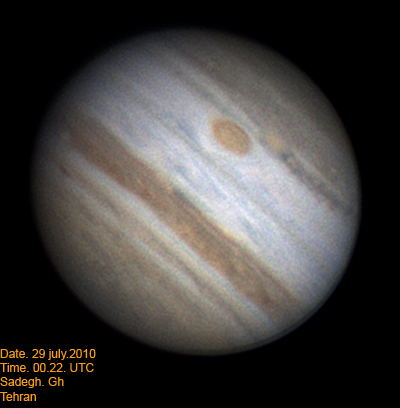

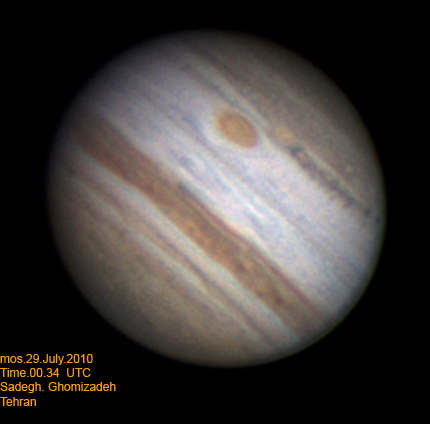
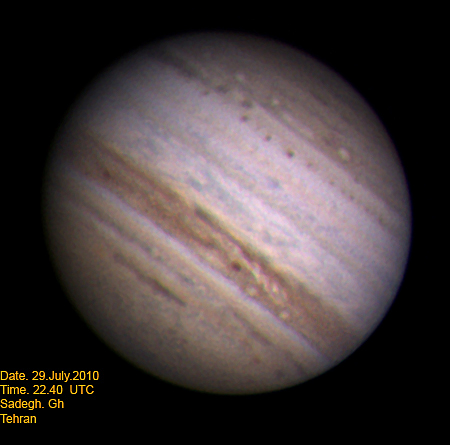
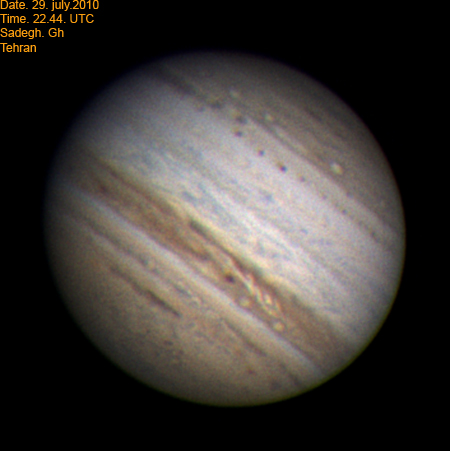
 [Sadegh ghomizadeh: Tehran IRAN ]
[Sadegh ghomizadeh: Tehran IRAN ]
|
George Tarsoudis ( 250mm Newtonian ) |
Pure seeing but it is interesting to see the GRS
Orion Optics Newtonian Telescope 250mm @ f/6.3,Unibrain camera Fire-i 785,filters RGB,barlow 3X.
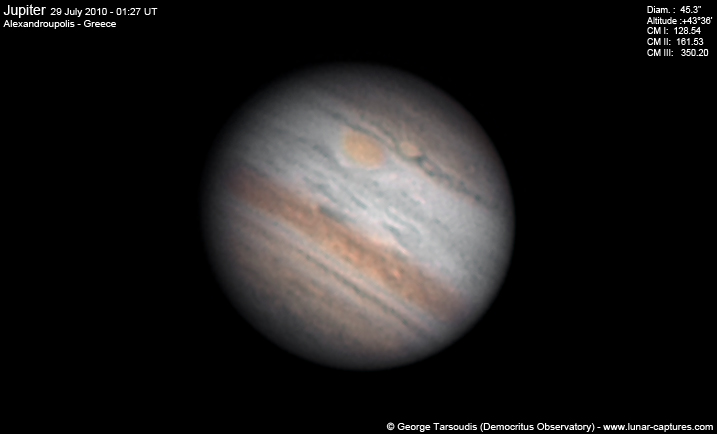
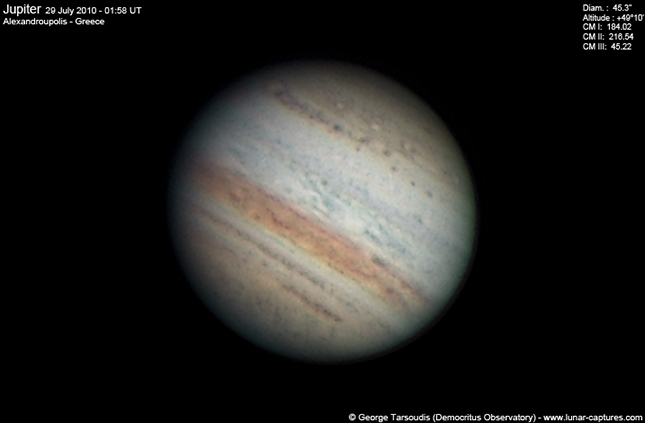
 [George Tarsoudis,Alexandroupolis of Greece]
《ターソウディス ギリシャ アレクサンドロポリス》
[George Tarsoudis,Alexandroupolis of Greece]
《ターソウディス ギリシャ アレクサンドロポリス》
|
Carlos E. Hernandez (Drawing:9-inch (23-cm) F/13.5 Maksutov- Cassegrain) |
I made an observation of Jupiter on August 3, 2010. I was able to make out a good amount of detail over the jovian globe. The detail visible over the jovian disk was impressive.
Date (U.T.): July 29, 2010
Time (U.T.): 05:00
L1 295.0*, L2 326.6*, L3 157.9*
Diameter (Equatorial): 45.1"
Instrument: 9-inch (23-cm) F/13.5 Maksutov-Cassegrain
Magnification: 129x and 310x
Filters: None (IL)
Seeing (1-10): 6-7, Antoniadi (I-V): II
Transparency (1-6): 4
Notes:
South Polar Region (SPR): Appears dark to dusky and mottled (3-4/10).
South South South Temperate Zone (SSSTZ): Appears dusky to dull (4-5/10) and mottled.
South South South Temperate Belt (SSSTB): Appears dusky (4/10) and irregular.
South South Temperate Zone (SSTZ): Appears dusky (4/10) with shaded to bright (6-7/10) s
mall ovals/rifts within it.
South South Temperate Belt (SSTB): Appears broad and dusky (4/10).
South Temperate Zone (STZ): Appears shaded to bright (6-7/10) with bright (7/10) sections
separated by dusky to dull (4-5/10) columns.
South Temperate Belt (STB): Appears broad and dark to dusky (3-4/10). The following portion
of it appears to diverge towards the north. It contains dark (3/10) condensations within it.
South Tropical Zone (STrZ): Appears bright (7/10) with no other detail visible within it.
South Equatorial Belt (SEB): The thin, dull (5/10) northern border of the SEB is visible.
Equatorial Zone (EZ): The EZ appears to contain a complex network of bluish-green condensa
tions and streaks (lace-type). Bright (7/10) areas are noted within the darker areas.
North Equatorial Belt (NEB): Appears dark to dusky (3-4/10) with dark (3/10) condensations
noted within it. A bright (7/10) oval is noted over it's preceding end and bright (7/10)
rifts are also noted over it's midsection. The southern border contains bluish-green festoons
which project into the EZ.
North Tropical Zone (NTrZ): Appears bright (7/10) without any other detail visible within it.
North Temperate Belt (NTB): Appears dark to dusky (3-4/10) and bisected. The southern component
appears to contain dark (3/10), elongated condensations.
North Temperate Zone (NTZ): Appears thin and shaded to bright (6-7/10).
North North Temperate Belt (NNTB): Appears dark to dusky (3-4/10) and broad.
North Polar Region (NPR): Appears dark to dull (3-5/10) with dusky (4/10) mottling noted within.
A wide field observation showing all four Galilean satellites. The satellites noted are
(preceding to following) Callisto (6.10m), Io (5.50m), Europa (5.78m), a star (HIP 1127),
and Ganymede (5.10m).
The best of luck to you, your family, and the members of ALPO Japan.

 [Carlos.E. Hernandez South Florida U.S.A ]
[Carlos.E. Hernandez South Florida U.S.A ]








[Sadegh ghomizadeh: Tehran IRAN ]


[George Tarsoudis,Alexandroupolis of Greece] 《ターソウディス ギリシャ アレクサンドロポリス》

[Carlos.E. Hernandez South Florida U.S.A ]
 ALPO-Japan Latest
ALPO-Japan Latest

 Jupiter Section
Jupiter Section